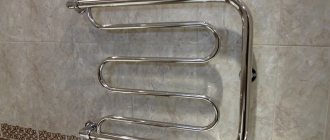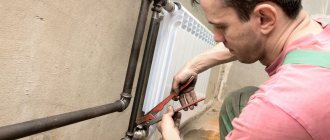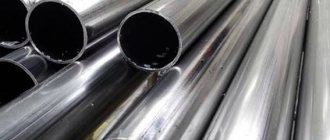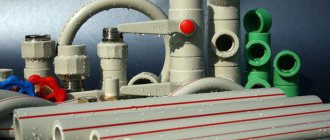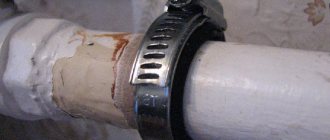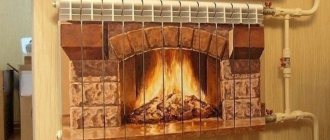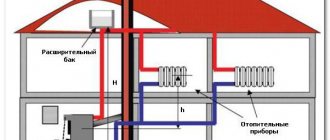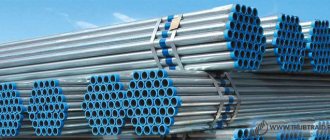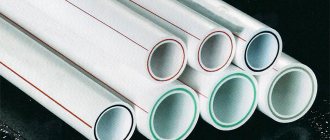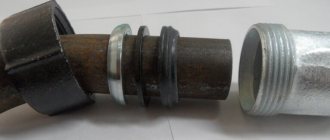The variety of paints and varnishes on the construction market is now so wide that sometimes even specialists are at a loss when faced with the choice of what to paint heating pipes with. Regularly repainting and tinting pipelines in an apartment is no longer interesting to anyone, so the requirements for the durability of the coating come first.
Properly selected paint will not only protect the metal from corrosion and emphasize the style of the room, but will also last a long time without cracking and maintaining its original color. By following the recommendations of professionals, you can quickly and efficiently paint pipes with your own hands.
Requirements for paint and varnish material
Before you start choosing paint for heating pipes, you need to decide what functions the coating should perform. The main task is, of course, to protect the metal from external corrosion. Recently, in order to give the elements of the heating system a decorative appearance, even plastic pipelines and heating devices already coated with a protective layer have been painted. In this case, you can use paint without anti-corrosion properties.
Before painting central heating pipes in an apartment, it is necessary to take into account such an important factor as smell. It doesn't just refer to unpleasant sensations during work. A strong, persistent aroma indicates the presence of toxic substances in the material and can be dangerous to human health in high concentrations. Due to the fact that it is difficult to ensure ideal room ventilation, it is worth giving preference to odorless paints.
To ensure that the applied coating does not fade or crack over time, it is necessary to take into account the operating conditions. Since the temperature in the heating system is elevated and usually fluctuates between 40 and 80 ° C, the paint must be resistant to such heat. For periodic cleaning of pipes from dust and other household contaminants, resistance to abrasion and aggressive environments is important.
Based on the above, paint for heating pipes should have the following properties:
- ability to withstand temperature changes and heating up to 90 °C;
- abrasion resistance;
- resistance to aggressive environments;
- good adhesion to the appropriate substrate;
- Possibility of application directly onto rust;
- odor and safety for human health;
- suitable color scheme.
Paint selection
To obtain the best effect, choose paints marked “for radiators” or similar. In this case, resistance to elevated temperatures and color retention are guaranteed. Of the inexpensive options, PF-115 enamel meets most of the listed requirements. Silicon-based heat-resistant enamel KO-168 also gives good results. It is better to avoid oil paints, since their color inevitably fades over time, the applied coating takes a long time to dry and smells noticeably all this time.
Important! To protect metal surfaces from environmental influences, the paint must contain a corrosion inhibitor. When using decorative pipe coating without this additive, you must first apply a layer of special primer for radiators. The most suitable lead primer is number 81.
Paints suitable for heating pipes are divided into 3 types:
- alkyd enamels;
- acrylic enamels;
- water-dispersed compositions.
Alkyd enamels are quite common due to their most affordable cost. This is where their advantages end. Alkyd enamel is the smelliest of the list of paints; even after drying for some time, it gives a characteristic unpleasant odor when the heating system is running, and fades slightly over time. The color change is especially noticeable in the case of painting white; for others this feature can be ignored. The period of complete drying is 24 hours, after 4 – 6 hours it is no longer sticky.
Acrylic enamels are based on organic solvents, so there is a specific smell when working with them, but it is noticeably less than the previous type. These paints have a very wide range of colors, dry in 1 hour, but in most cases require preliminary priming of metal surfaces. Acrylic paints come in glossy and matte. The former shine beautifully, and the latter hide the unevenness of the surface being painted well. At the same time, the original color brightness is preserved.
Water-dispersed paints are considered the safest for health. At the same time, they are not inferior to others in terms of durability and beauty of the coating. These are quick-drying, odorless paints. You just need to check that there is a special mark on the can, indicating that it can be used for heating devices.
The most popular paint brands now are:
- Heitzkorperlak;
- Radiator Paint;
- Elementfarg Alkyd;
- Millertemp;
- Mipaterm 600;
- Radiator;
- Primer enamel UNIPOL;
- Enamel VD-AK-1179;
- Enamel GF-0119.
As for color, it all depends on the features of the interior, lighting and aesthetic taste of the owners. In addition to the standard spectrum, you can use metallic paints like gold, silver, chrome, bronze, combine different colors or apply patterns. From a heating engineering point of view, dark shades are preferable, as they promote better heat transfer.
Composition selection
To ensure the best effect from using paint for heating pipes, when choosing a composition in a store, it is better to purchase paint with the inscription “for heating radiators” or a similar mark. Such a coloring mixture will be resistant to high temperatures, and when heated it will not change its color. One of the budget options is PF-115 enamel, which meets almost all the basic requirements given above. Heat-resistant paint KO-168, which has a silicon base, is also very good.
It is better not to use oil paint for pipes heated to high temperatures, since the oil composition will certainly fade or turn yellow after some time. In addition, oil dyes have an unpleasant, persistent odor during painting and drying.
Attention! If you choose paint for metal pipes, it must contain a corrosion inhibitor that will protect the metal surface from moisture in the air. If the composition does not contain such an additive, then before painting, the heating pipes must be coated with a layer of anti-corrosion primer. One suitable primer is lead-lead primer mixture No. 81.
Alkyd enamel for heat-conducting pipes
This enamel consists of alkyd varnish (pentaphthalic, glyphthalic) with the addition of vegetable oils and a solvent (white spirit). It has high elasticity and is quite durable. Currently, these enamels are popular and are used in many areas of painting.
The advantages of alkyd enamels include:
- Affordability.
- Resistance to high temperatures (the range is usually indicated on the packaging of this material).
- Excellent hiding power in a relatively thin layer.
- Ease of application to the product.
- Does not turn yellow during use.
- Increased wear resistance.
- Wide range of colors.
- Availability of aerosol version.
However, alkyd paints have not only advantages. The disadvantages include:
- There is a pungent odor because the composition of these enamels includes white spirit. The smell lasts for several days. It is also possible for it to appear after the first start of the heating system.
- Long time for complete drying (24 -36 hours), which increases the time for painting work.
Alkyd enamel PF-223 is quite suitable as a paint for heating pipes; PF-115 can also be used for heating systems.
Heat-resistant acrylic enamel
Odorless pipe paint is acrylic enamel. Due to the fact that it does not have a pungent odor, this enamel is an ideal paint and varnish material for work carried out inside residential premises. The painted surface becomes absolutely smooth and tactilely resembles plastic.
Since not all acrylic enamels are heat-resistant, when purchasing, you must carefully read the information regarding the temperature range of its use. The minimum value for using these enamels is 80 ºС.
A significant advantage of these paints is their drying time - for the first layer the value ranges from ten minutes to one hour, and from one to two hours for the second. To achieve a high-quality result, it is necessary to prime the surface to be painted. When carrying out work, it is necessary to avoid contact with moisture on the surface to be painted.
The consistency of acrylic resembles medium-thick sour cream; it does not spread, which eliminates the possibility of smudges. As stated above, this enamel should be applied to a previously primed surface in two layers. Violation of painting technology entails a significant deterioration in its quality.
The only drawback of using this material is its low resistance to mechanical loads.
Silicone and powder paints for metal
These two types of paints are the most resistant to high temperatures.
We recommend: Water in-floor heating convectors: their types and characteristics
If the heating system is systematically exposed to overheating, then silicone paint is exactly what you need to paint the heating pipes with. After all, this coating is guaranteed to withstand heating up to 350 ºС. This paint consists of silicone resin with the participation of aqueous solvents. Semi-matte shine is a characteristic feature of the dried layer of this paint.
Silicone paint is unpretentious when painting - it does not require priming and is applied directly to the metal. Resistant to external influences. Durable. The disadvantages include the high price.
Powder paint is the most stable and durable of paints and varnishes at present. Used in industrial conditions.
Instructions for painting pipes
In order for the result to be pleasing and the painting work not to have to be redone, spending extra money and time, it is necessary to adhere to the technology and follow the recommendations of specialists. The quality of preliminary surface preparation often has a greater impact on the durability and aesthetics of the coating than the choice of paint.
Preparatory work
First of all, you need to take care of protecting the floor, walls and surrounding objects. Old newspapers, magazines, oilcloth or construction film are suitable for this. No matter how hard you try to do everything carefully, paint can still drip or splash in the most inappropriate place. Therefore, it is better to play it safe so as not to think later than to remove paint stains.
On a note! Personal protective equipment will be useful for work: gloves, a hat, work clothes that you don’t mind getting dirty. If you use paint with a smell, you will also need a respirator.
Before painting, the surface of the pipes must be cleaned of dust, dirt and old paint. If the previously applied layers of paint are thin enough, adhere well and do not crack, then you can leave them and just get by with sanding them with sandpaper. Areas with rust need to be treated especially carefully. White spirit or any slightly alkaline solution works well for degreasing the surface.
You can get rid of old paint in the following ways:
- Using a special rinsing solution.
A gel-like liquid is applied to the surface and covered with film. After a short period of time, the old coating softens and is easily removed with a spatula, scraper or wire brush. Paint remover has a strong odor and contains aggressive toxic substances, so you must work with extreme caution.
- Using a blowtorch.
The paint heats up and comes off easily under the pressure of a spatula or similar tool. Can only be used when working outdoors.
- Using a hair dryer.
Due to heating, the old coating easily comes off and can be cleaned off with any sharp object. This method is similar to the previous one, only simpler and safer, and can be used in any room. Due to the ability of metal to quickly give off heat, it is not always possible to warm it up well, so in some cases using a hair dryer will be ineffective.
- Using a drill or grinder with a wire brush attachment.
Old paint can be cleaned off quite quickly, but in hard-to-reach places the brush is powerless; you need to use a narrow spatula, knife or chisel.
The best way to remove paint from pipes and radiators depends on the availability of suitable tools and subjective individual preferences. But in any case, the old cracked coating must be removed so that the new one fits well and lasts a long time. Then the surface is degreased, wiped with a damp cloth and dried.
After complete cleaning of all accumulated layers or when dealing with a new uncoated metal surface, an anti-corrosion primer should be applied if the paint does not contain special protective components. In some cases, the ability of the primer to improve adhesion to the substrate is important. If you use 3-in-1 paint containing a rust converter, primer and color pigments, you can immediately begin applying it without prior preparation.
Important! Regardless of the type of paint and varnish material, work should be carried out in a well-ventilated area. Any paint fumes contain substances that should not be inhaled unnecessarily. Therefore, it is recommended to ensure that pets, children and other family members are away from you during painting.
Applying paint
There are several methods to paint pipes:
- With a brush;
- Roller;
- Spray can;
- Spray gun or spray gun.
Applying paint with a brush is the most common and affordable option. No special skills are required. It’s enough just to take a good brush and, picking up a small amount of paint on the tip, spread it evenly, slowly, over the surface. You must strive to make the layer as thin as possible. This will ensure uniform coverage and no smudges. If the paint shows through, it is better to paint it again later than to apply one thick layer.
Advice! Cheap brushes often have bristles that fall out. Therefore, it is not worth saving on their cost. However, even high-quality specimens sometimes leave hairs. If necessary, lint can be removed with a needle.
It is very convenient to paint pipes and batteries using a special radiator brush. It has a long handle and a curved shape that makes it easy to cover all those hard-to-reach areas.
Using small-diameter foam rollers, it is convenient to paint an openly located pipeline if there is free space around. They are also suitable for the front surface of heating devices. Craftsmen even make special devices from two rollers, allowing not only to ensure an even application, but also to complete the job very quickly.
Sometimes simple scouring pads are used for smooth pipes, allowing you to apply a neat thin layer on all sides. The gloves will, of course, be dirty, but the painting will be completed in no time.
Working with a spray can is the most convenient and fastest. It must be shaken for a minute and can be sprayed onto the prepared surface. Performing smooth zigzag movements, gradually cover the required area. It is important to maintain the distance recommended by the manufacturer and not stay in one place for too long.
Aerosol cans provide a beautiful decorative finish, but are expensive and do not cover hard-to-reach areas well. In this regard, they are usually applied to a well-primed base or after a preparatory background coat of paint.
A professional spray gun is used quite rarely in everyday life, but if there is a lot of painting work to be done, then it is worth acquiring this device. The sprayer allows you to quickly apply even layers with minimal paint consumption and has special nozzles for ease of working with surfaces of the most intricate shape.
Useful tips
Expert advice on how best to paint heating pipes will help you do the work yourself with the best results:
- When removing the old layer of paint, it is important not to overdo it, applying force so as not to damage the pipe connections.
- It is necessary to open the container with paint remover very carefully, holding the bottle with the neck away from you, so as not to inhale toxic fumes. Work with this caustic substance can only be carried out if the room is well ventilated.
- If it is possible to dismantle the heating devices, this will significantly facilitate the painting process. Radiators can be taken outside and painted in the fresh air, turning them on the convenient side.
- It is best to paint pipes and radiators with the heating system turned off. Otherwise, the paint will lie unevenly on hot surfaces, and there may be streaks, blisters, spots and streaks.
- If it is necessary to carry out work during the heating season, you can get out of the situation by closing the valves on the batteries and waiting for them to cool completely. At the same time, the room will become noticeably colder, and only the radiators will be well painted, since the pipes will still remain hot.
- You need to paint from top to bottom with gentle movements, slowly.
- You should strive to paint the surface on all sides, and not just the front. Otherwise, the remaining parts will rust, and unpainted areas are always noticeable, although not at first glance.
Painting stages
It should be taken into account that even the highest quality and most expensive paint will not guarantee a successful result if the surface of the pipelines has not been properly prepared.
Preparing for painting
Painting of pipes should begin only when they are cleaned of dirt, old paint, sanded, degreased and primed. We offer you an indicative algorithm of actions for preparing the heating main for painting.
- remove all dirt and dust from pipes and radiators using a damp cloth or brush;
- clean the surface to a metallic shine with sandpaper or a special drill attachment;
- sanding and degreasing with white spirit or other solvent;
- treatment with anti-corrosion primer.
When preparing pipes for painting, you can use some tips. You can soften old paint and rust using a chemical remover, and then easily remove it with a spatula. It is better to use an alkyd-based primer, because it will improve the adhesive characteristics of the metal surface, and the paint will adhere better to the surface.
How is painting done?
Before painting pipes and radiators, cover the floor under the heating line with film or old newspapers. The wall behind the battery can be covered with masking tape or protected with a sheet of thick cardboard.
Use a small soft bristle brush, foam roller or spray gun. The choice of tool depends on your skills and the specific features of a given heating line.
The tops of the pipes and radiators should be painted first. The bottom of the pipe is painted last, so as not to spoil it with smudges and stains. If you need to apply multiple layers of paint, allow time for each coat to dry.
If you use a spray gun or spray paint, the painting process will go much faster. However, first study the sprayer’s operating instructions and find out from what distance the pigment can be transferred.
